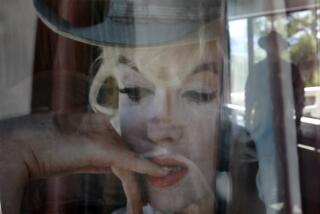Neighbors Find Nothing Funny About Mark Twain’s Cabin
- Share via
JACKASS HILL, Calif. — Mark Twain, America’s most celebrated humorist, would have been the first to laugh at the controversy over the cabin where he wrote “The Celebrated Jumping Frog of Calaveras County.”
It was the short story that made him famous.
Twain came here as a penniless journalist in 1865 and heard the story of a talented frog that could outjump any competitor. It was an old tale that had circulated through mining camps of the Mother Lode country.
The frog belonged to a man called Coleman, whose name Twain changed to Smiley when he repeated the story in print.
Jump on Command
Smiley had trained the frog to jump on command. A stranger came into his camp, accepting a wager from Smiley that his frog could leap farther than any other. The stranger had no frog, so Smiley offered to go outside and find one, leaving his champion on the table. The stranger weighted it with buckshot.
Smiley returned with a frog for the contest. It promptly hopped across the cabin. Smiley’s high jumper was unable to move. The stranger pocketed the $40 bet and left.
Twain jotted the tale down in his notebook, a journal that was to furnish him with material throughout his literary career.
The Tuolumne County cabin where Twain spent several months burned during the 1890s. The current cabin is a replica constructed in 1922 as a tourist attraction. The actual site is believed to have been nearby. A bronze plaque erected on Highway 49 says that the chimney and fireplace are original, but there are those who argue that this has never been substantiated. Regardless, about 20,000 people visit the site each year, which is several miles north of Sonora.
The cabin has so deteriorated that an iron fence has been erected around the structure to prevent visitors from entering.
“We don’t want anyone injured,” said Steve Szalay, the Tuolumne County administrator whose office is in Sonora. The county owns the property. “We fully intend to have a monument or some form of recognition to Twain. Our local historical society wants to restore the cabin. First we want to talk to some of the neighbors and see how they feel.”
Minnie MacDonald, 85, lives across the street from the Twain cabin. She was born on Jackass Hill, and she wishes the county would move the ramshackle building to another location, possibly to nearby Columbia State Park.
“People used to camp inside the place before they put the fence around it,” she recalled. “They’d be having parties and littering the ground with beer cans. We’d call the sheriff and he would run them off, but others would come.”
Reuben Oblender and his wife, Lucille, have been living on Jackass Hill for 20 years. He says that there are about a dozen families in the tiny community, and all his neighbors want the cabin moved.
“The county doesn’t maintain the road that comes up here from Highway 49,” he said. “People drive up here to look at the cabin and are disappointed. That’s putting it mildly. Often they are angry because they discover such a dilapidated shack. So they rush back down the hill. The road isn’t built for that kind of traffic. Someday, there’ll be an accident, or someone will hit one of my dogs.”
Twain was the pseudonym of Samuel Langhorne Clemens, who was born in the small village of Florida, Mo., on Nov. 30, 1835. His family later moved to Hannibal, Mo., another town on the Mississippi. He became a pilot on the steamboats plying the majestic waterway.
In 1861, the young Clemens boarded a stagecoach bound for the Far West. After an unsuccessful attempt to strike it rich in silver mining, he drifted into Virginia City, Nev., in 1862, and got a job as a reporter for the Territorial Enterprise, where he began writing humorous articles about the Comstock Lode. It was there he began to use the pen name Mark Twain. In river-boat parlance, it meant two fathoms, or 12 feet, the shallowest depth a steamboat could navigate without the danger of running aground.
Good Time to Leave
Twain moved on to San Francisco, becoming city editor of the Call. He spent his evenings in Barbary Coast saloons with a pugnacious drinking companion, Steve Gillis. One night Gillis became embroiled in an altercation with a saloon proprietor named Big Jim Casey. Gillis knocked his adversary cold.
Twain raised bail for his friend, but it was a propitious time to leave San Francisco. The saloonkeeper was a friend of the city’s police chief, and Twain’s articles about corruption in the city’s police department had made him unpopular with the gendarmerie.
It was at this point that Gillis’ brother, Jim, offered Twain the use of his cabin in the gold country. Steve Gillis jumped bail and the two came here to Jackass Hill. Later, Twain would describe the cabin as it appeared when they arrived on Dec. 12, 1865:
“It had no planking on the floor, old bunks, pans and traps of all kinds. . . .” Twain noted, however, that despite the barren interior, Gillis was an avid reader. There were numerous volumes--Byron, Shakespeare, Bacon, Dickens and others--to provide enjoyable reading by the fireside.
Jackass Hill had been the locale of rich coarse gold deposits, having peaked in its output around 1851. The hill received its name from the braying of jackasses in the pack trains that stopped overnight on their way to and from the mines. As many as 200 might be tethered here at one time.
The community of Jackass Gulch that has vanished was located some distance from the hill near present Highway 49. When Twain arrived, the community was nearly a ghost town. He described it in his autobiography:
“Jackass Gulch had once been a rich and thriving surface-mining camp. By and by its gold deposits were exhausted; then the people began to go away and the town began to decay, and rapidly; in my time it had disappeared. Where the bank and the city hall and the church and the gambling dens and the newspaper office and the streets of brick blocks had been, was nothing now but a wide and beautiful expanse of green grass, a peaceful and charming solitude. Half a dozen scattered dwellings were still inhabited and there was still one saloon of a ruined and rickety character struggling for life, but doomed.”
“The Celebrated Jumping Frog of Calaveras County” was published in the New York Saturday Press in the fall of 1865, where the short story brought Twain acclaim from Eastern readers.
He commented in his autobiography:
“In October, 1866, I broke out as a lecturer, and from that day to this I have always been able to gain my living without doing any work; for the writing of books and magazine matter was always play, not work. I enjoyed it; it was merely billiards to me. . . .”
He married Olivia Langdon, the sister of a friend on Feb. 2, 1870.
Twain’s most prolific years began when they moved into a large Victorian house in Hartford, Conn., in 1874 and where they resided until 1881, raising three daughters. The house was a marked improvement over the rough cabin on Jackass Hill where he had lived briefly in near poverty less than a decade earlier. It had 19 rooms, five baths, a huge study and a billiards room. There were quarters for six servants. Here he would write “Tom Sawyer,” “Huckleberry Finn,” “Life on the Mississippi,” “The Prince and the Pauper” and “A Connecticut Yankee in King Arthur’s Court.” His books established him as the nation’s leading humorist and supported a lavish life style. He died in 1910 in Redding, Conn.
Paul Zall, author and professor of American studies at Cal State Los Angeles, said Twain was “the incarnation of democratic America. As a writer and lecturer he created Americans’ image of themselves that they tried to live up to and the image of Americans that Europeans knew: irreverent, independent, big-hearted, exuberant, and noisy--a fun nation, always laughing at themselves.”
Sharon Marovich of Sonora is a past president of the Tuolumne County Historical Society. She is also a member of the Sonora City Council, “the second woman in 138 years to hold the office since the town was incorporated,” she comments with a trace of pride. Marovich is supported by many others determined to preserve the cabin. Tuolumne County’s Board of Supervisors will make the final decision.
“We don’t want to move it,” she said. “It belongs here. People should have the experience of walking in Mark Twain’s footsteps. Twain’s books are timeless. We want to honor his literary legacy.”
More to Read
Sign up for The Wild
We’ll help you find the best places to hike, bike and run, as well as the perfect silent spots for meditation and yoga.
You may occasionally receive promotional content from the Los Angeles Times.






